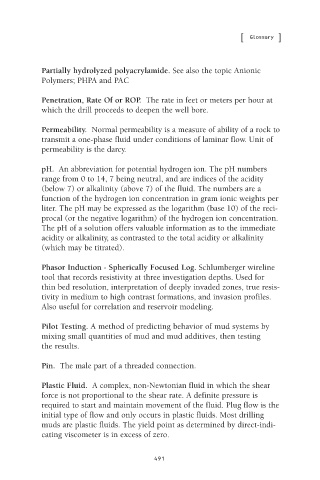Page 515 - Practical Well Planning and Drilling Manual
P. 515
Appendix NEW! revised 11/00/bc 1/30/01 3:30 PM Page 491
[ ]
Glossary
Partially hydrolyzed polyacrylamide. See also the topic Anionic
Polymers; PHPA and PAC
Penetration, Rate Of or ROP. The rate in feet or meters per hour at
which the drill proceeds to deepen the well bore.
Permeability. Normal permeability is a measure of ability of a rock to
transmit a one-phase fluid under conditions of laminar flow. Unit of
permeability is the darcy.
pH. An abbreviation for potential hydrogen ion. The pH numbers
range from 0 to 14, 7 being neutral, and are indices of the acidity
(below 7) or alkalinity (above 7) of the fluid. The numbers are a
function of the hydrogen ion concentration in gram ionic weights per
liter. The pH may be expressed as the logarithm (base 10) of the reci-
procal (or the negative logarithm) of the hydrogen ion concentration.
The pH of a solution offers valuable information as to the immediate
acidity or alkalinity, as contrasted to the total acidity or alkalinity
(which may be titrated).
Phasor Induction - Spherically Focused Log. Schlumberger wireline
tool that records resistivity at three investigation depths. Used for
thin bed resolution, interpretation of deeply invaded zones, true resis-
tivity in medium to high contrast formations, and invasion profiles.
Also useful for correlation and reservoir modeling.
Pilot Testing. A method of predicting behavior of mud systems by
mixing small quantities of mud and mud additives, then testing
the results.
Pin. The male part of a threaded connection.
Plastic Fluid. A complex, non-Newtonian fluid in which the shear
force is not proportional to the shear rate. A definite pressure is
required to start and maintain movement of the fluid. Plug flow is the
initial type of flow and only occurs in plastic fluids. Most drilling
muds are plastic fluids. The yield point as determined by direct-indi-
cating viscometer is in excess of zero.
491

